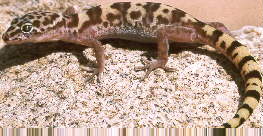Pink Geckos
And Other Arizona Geckos




Our pink geckos are actually called Mediterranean geckos (Hemidactylus turcicus). As the name suggests, they are not native to the American desert; they were introduced from the Middle East and India. Mediterranean geckos are 4-5" long when full grown, and like most geckos they can wall vertically up walls and upside-down on ceilings. Their pink color is due to their thin, translucent skin. They have tiny dark and light spots on their backs and alternating dark and light bands on their tails. Their eyes are large and dark with no eyelids. They can produce a chirping sound, but this is only heard when territorial males are fighting.
Mediterranean geckos prefer to live in or near occupied buildings, such as our house. During the day they hide in rock crevices, under palm leaves, and between the boards on the porch roof. They hunt insects at night, and sometimes two or three can be seen prowling around the same porchlight or lighted window. Only the tiny (2" long) juveniles appear inside the house; they have an inexplicable ability to crawl through the cracks around and under the doors. Inside the house, the dog is their natural predator, and the young geckos are poorly camouflaged on our walls and floors, so we put the geckos outside whenever we find them.
Why did we name our house and home page after the geckos instead of ourselves? For one thing, there are clearly more geckos living on our property than humans, and they brazenly roam the house as they please. Furthermore, they're helpful residents, since they serve as natural exterminators, keeping down the insect population.

 Another species of gecko which lives in Arizona (but not at our house) is the banded gecko (Coleonyx variegatus). It is slightly larger than the Mediterranean gecko, and unlike that gecko, it has moveable eyelids. Banded geckos prefer the open desert to inhabited houses. They hide in the shade during the day and hunts insects at night. They wave their tails in a cat-like manner when stalking their prey. They chirp when caught.
Another species of gecko which lives in Arizona (but not at our house) is the banded gecko (Coleonyx variegatus). It is slightly larger than the Mediterranean gecko, and unlike that gecko, it has moveable eyelids. Banded geckos prefer the open desert to inhabited houses. They hide in the shade during the day and hunts insects at night. They wave their tails in a cat-like manner when stalking their prey. They chirp when caught.

 The leopard gecko (Eublepharis macularius) is not an Arizona gecko (it's actually from the region of Pakistan and India), but there is one living at our house, in a terrarium. She's named Cat after the cat-like way she stalks her prey and arches her back when stroked. She looks very much like the leopard gecko shown at right (although the gecko in the picture is not Cat). She has moveable eyelids but lacks the pads that allow most geckos to walk up vertical surfaces and upside-down (which is just as well, since it keeps her in the terrarium). She hides in a cactus husk or by the water dish during the day and roams the terrarium at night. She eats crickets and mealworms rolled in vitamin and calcium powder. She chirps sometimes when picked up.
The leopard gecko (Eublepharis macularius) is not an Arizona gecko (it's actually from the region of Pakistan and India), but there is one living at our house, in a terrarium. She's named Cat after the cat-like way she stalks her prey and arches her back when stroked. She looks very much like the leopard gecko shown at right (although the gecko in the picture is not Cat). She has moveable eyelids but lacks the pads that allow most geckos to walk up vertical surfaces and upside-down (which is just as well, since it keeps her in the terrarium). She hides in a cactus husk or by the water dish during the day and roams the terrarium at night. She eats crickets and mealworms rolled in vitamin and calcium powder. She chirps sometimes when picked up.

© 1997 e-hanger@primenet.com